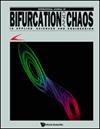分数阶离散神经元图谱中的无限多共存吸引子和卷轴
IF 2.3
4区 数学
Q2 MATHEMATICS, INTERDISCIPLINARY APPLICATIONS
引用次数: 0
摘要
神经网络激活函数使神经网络具有更强的拟合能力和更丰富的动态行为。本文提出了一种以非线性周期函数为激活函数的改进型分数阶离散塔布学习神经元(FODTLN)模型图。本文讨论了该模型图的固定点。然后,利用一些常用的非线性动力学分析方法,结合分数阶近似熵方法,研究了该图在不同参数和阶次条件下丰富而复杂的动力学行为。此外,研究还发现分数阶微分算子会影响多卷积的产生,并且该模型通过改变初始条件可获得无限多的共存吸引子。有趣的是,还发现了吸引子的增长和状态转换。最后,在 DSP 硬件平台上实现了该地图,以验证其可实现性。结果表明,该图谱表现出复杂而有趣的动力学行为。它为人工神经网络研究提供了基础理论。本文章由计算机程序翻译,如有差异,请以英文原文为准。
Infinitely Many Coexisting Attractors and Scrolls in a Fractional-Order Discrete Neuron Map
The neural network activation functions enable neural networks to have stronger fitting abilities and richer dynamical behaviors. In this paper, an improved fractional-order discrete tabu learning neuron (FODTLN) model map with a nonlinear periodic function as the activation function is proposed. The fixed points of the map are discussed. Then, the rich and complex dynamical behaviors of the map under different parameters and order conditions are investigated by using some common nonlinear dynamical analysis methods combined with the fractional-order approximate entropy method. Furthermore, it is found that fractional-order differential operators affect the generation of multiscrolls, and the model has infinitely many coexisting attractors obtained by changing the initial conditions. Interestingly, attractor growth and state transition are found. Finally, the map is implemented on the DSP hardware platforms to verify the realizability. The results show that the map exhibits complex and interesting dynamical behaviors. It provides a fundamental theory for the research of artificial neural networks.
求助全文
通过发布文献求助,成功后即可免费获取论文全文。
去求助
来源期刊
CiteScore
4.10
自引率
13.60%
发文量
237
审稿时长
2-4 weeks
期刊介绍:
The International Journal of Bifurcation and Chaos is widely regarded as a leading journal in the exciting fields of chaos theory and nonlinear science. Represented by an international editorial board comprising top researchers from a wide variety of disciplines, it is setting high standards in scientific and production quality. The journal has been reputedly acclaimed by the scientific community around the world, and has featured many important papers by leading researchers from various areas of applied sciences and engineering.
The discipline of chaos theory has created a universal paradigm, a scientific parlance, and a mathematical tool for grappling with complex dynamical phenomena. In every field of applied sciences (astronomy, atmospheric sciences, biology, chemistry, economics, geophysics, life and medical sciences, physics, social sciences, ecology, etc.) and engineering (aerospace, chemical, electronic, civil, computer, information, mechanical, software, telecommunication, etc.), the local and global manifestations of chaos and bifurcation have burst forth in an unprecedented universality, linking scientists heretofore unfamiliar with one another''s fields, and offering an opportunity to reshape our grasp of reality.

 求助内容:
求助内容: 应助结果提醒方式:
应助结果提醒方式:


